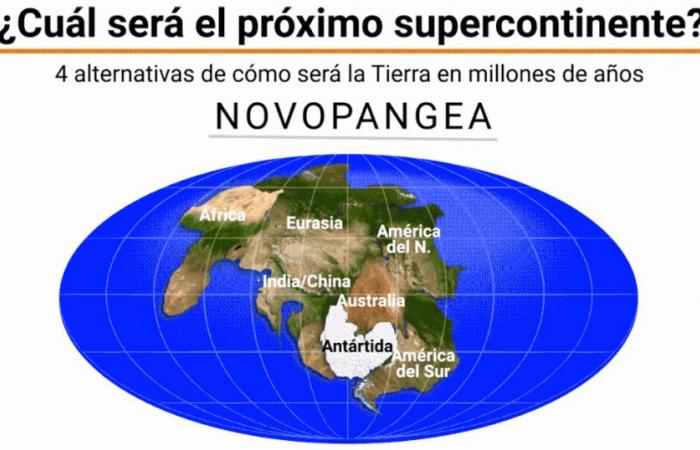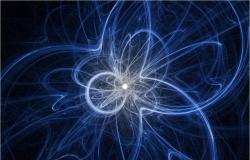Cartography has always shown us the same planet Earth. America separated to one side with its subcontinents and on the other side, very close to each other, the rest: Africa, Europe, Asia and Oceania. Below, almost relegated, Antarctica. We have known the arrangement since school, but the truth is that the continents separate and reassemble in cycles. Every hundreds of millions of years, they join together into uniform masses known as supercontinents, only to break apart again hundreds of millions of years later.
In fact, all the continents of the planet were once concentrated in what is called Pangea and before that there were, they estimate, between 6 and 10 more variations. Geologists, aware of cyclical movements, try to predict what the next supercontinent, how the tectonic plates will be organized in the next cycle of planet Earth.
The answer is not unanimous. It is an open debate that, for the moment, leads to four main alternatives. Where there is no discussion is that it will actually happen. The continents will move and come together again. Where? As? When?
“The joining of continents is called the Wilson cycle, which is the long-term process (every 500 to 600 million years) in which Earth’s continents form into a giant supercontinent. They do not necessarily all have to be part of this phenomenon. It happens because the earth’s crust is thicker and denser compared to the oceanic crust,” said the geologist. Alexander Farnsworthprofessor at the University of Bristol, in dialogue with Infobae.
As he explained, the continental crust conducts less heat. The mantle under this thick crust heats the continent for very long periods, pushing it up and to the sides. Over time, the process causes it to fracture and create a crack. Crack that will widen and widen, forcing the now two tectonic plates to move away from each other as new oceanic crust emerges in that crack.
Experts agree that it is an intrinsic consequence of the unique physical, chemical and energetic state of the Earth during the second half of its life. Plate tectonics became a dominant piece interacting with Earth’s deep mantle in a feedback system lasting about 600 million years.
Pangea formed about 310 million years ago and began to break apart 180 million years ago. Therefore, we are now going through the middle of a cycle. It is estimated that between 200 and 250 million years the next supercontinent will form. The configuration of the planet will change completely.
Joao Duarte, researcher and professor of geology at the University of Lisbon, believes that there are two reasons that explain the cyclical nature of the Earth. On the one hand, a “geometric” effect. “Oceanic crust is constantly recycled in subduction zones (when one plate lies beneath another) because oceanic plates become denser than the underlying mantle. However, the continental portion of the plates resists subduction because they are less dense than the underlying mantle (they are buoyant). So if there are plates moving around the Earth’s surface, being dragged by plates sinking into the mantle, the continents will collide at some point. And it may be that from time to time most of the continents come together,” he explained to Infobae.
To this is added a dynamic foundation, linked to a physical law: that the continents always move in specific directions towards specific locations, controlled by processes that occur in the mantle. “Some computer models seem to show that the truth is somewhere in between: the interaction between plates, continents and mantle dynamics results in some type of statistical cyclicity,” he said.
In an article in The Conversation, Duarte proposes 4 possible configurations. Called Novopangea, Aurica, Pangea Ultima and Amasia. The most probable scenario, he believes, is that of Novopangea since “it would obey the logical progression of the current directions adopted by the drifting continental plates.” In this case, the American continent would collide with Antarctica, which would be drifting north and then collide with the already united Africa and Eurasia.
However, he was in charge of proposing an alternative in 2018 that he called Aurica.
-What is Aurica about?
-In Aurica we propose the simultaneous closure of the Atlantic and Pacific oceans. This would be possible whenever another ocean opened, for example around the Indian Ocean. The scenario was also based on dynamic reasoning. Both the Atlantic and Pacific Oceans have ancient crust and subduction zones and are therefore likely to close. We call the supercontinent Aurica because the land masses of Australia and the Americas would be located at its center.
-What would be the consequences of a supercontinent that is not divided by an ocean?
-The climate would be very different. An equatorial supercontinent would be very hot. A polar supercontinent would be very cold. Species would adapt to this, of course. But that means evolution will take over. It is very unlikely that humans will be here – as we are now – in 200 million years. We will be a completely different species. Evolution happens and changes things on these time scales. For example, 200 million years ago the Earth was ruled by dinosaurs.
-In the future, are these only four possible scenarios or could more arise?
-It actually helps if we think of these potential supercontinents as end members of a spectrum of possibilities. The truth may be somewhere in between. There are many continents moving, dividing and recombining. Complex things will happen.
One of the most apocalyptic hypotheses is the one postulated by Alexander Farnsworth and his team at the University of Bristol. Pangea Ultima, if the forecast comes true, will be uninhabitable for almost all mammals, humans included, due to the extreme climatic conditions it would present. According to an article published in Nature Geosciencethe scenario would lead to a new mass extinction of the species within 250 million years.
“We can be pretty sure that a supercontinent will form,” Farnsworth said. This is a natural process on Earth and will not stop until the oceans evaporate and the continents merge into one. The sun gets brighter as it ages, we have observed it and it will continue to happen. We can also be fairly certain that a natural consequence of supercontinent assembly will lead to increased volcanism and increased atmospheric carbon dioxide.
-What is it that cannot be assured then?
-The most uncertain thing is where the supercontinent will form. We predict it will form at the equator, which is consistent with other predictions that also show this is likely. In fact, in the past many supercontinents were centered on the Equator.
A supercontinent centered on the equator would have devastating climate consequences. Typical temperatures would range between 40 and 50 degrees, with even higher peaks that would be aggravated by unsustainable levels of humidity. Researchers estimate that only between 8 and 16 percent of the planet would be habitable by mammals and that species would have to undergo major mutations to survive.
There are three factors that will affect extreme heat. Carbon dioxide in the atmosphere and the brightness of the sun – that is, the amount of energy it emits – at current levels is one of them. Just by changing the configuration of the planet, grouping it into a supercontinent, the temperatures of the Earth’s surface skyrocket.
Likewise, the sun will be 2.5% brighter in the next 250 million years, which will add more heat to the Earth. Lastly, Pangea Ultima would create more volcanic outgassing that is emitted into the atmosphere.
“In fact, this could be even worse, the formation of supercontinents has also been linked to the formation of Great Igneous Provinces, which are very large volcanic eruptions, synonymous with mass extinctions in the past. However, we did not include this type of volcanism because it is very difficult to predict,” Farnsworth added.
Not everything is hopelessness. A recent reconstruction, called Amasia, predicts that the next supercontinent could be centered at the North Pole. If there were a supercontinent located there, mammals, both humans and animals, would have a better chance of surviving.
Two years ago, a study published in the journal National Science Review, revalidated one of the hypotheses that was already being considered. Researchers at Australia’s Curtin University found that the supercontinent called Amasia is a likely option for the distant future, the next 250 to 300 million years. That future could be found in the North Pole as a center.
In Amasia, the Pacific Ocean would disappear once America collides with Asia. Before that, Australia would have joined Asia and served as a connection point with America. This scenario, they say, would be more conducive to human life. The temperatures would be more tolerable than in other alternatives.
“At the moment, the best we can do is give educated guesses. “If supercontinents are assembled alternately by introversion and extroversion (whether the previous ocean survives or not), then the next supercontinent would form by introversion by closing the Atlantic and Indian oceans,” the professor explained. Zheng-Xiang Lico-author of the study, in dialogue with Infobae.
-What percentage of possibility do you assign to Amasia?
-Our numerical simulation of the supercontinent cycle via a supercomputer showed that as the Earth cools over time, the next supercontinent is more likely to form as the Pacific Ocean closes. If I have to put a number on my confidence in this prediction, maybe around 50%.
-What would living conditions be like on this supercontinent?
-We will probably have a fairly arid supercontinent interior, with large daily temperature variations. Without an ocean dividing the continents, overall biodiversity may not be as good as what we have been enjoying.
-In that context, would human beings survive?
-Human beings are a tough and super intelligent species. We survived an ice age without the help of any modern technology. We may lose some beaches, but we will gain some new mountain ranges. Taking into account the time left to get there, we can evolve to adapt to any changes that nature throws at us. Evolve as humans have done all their lives.






